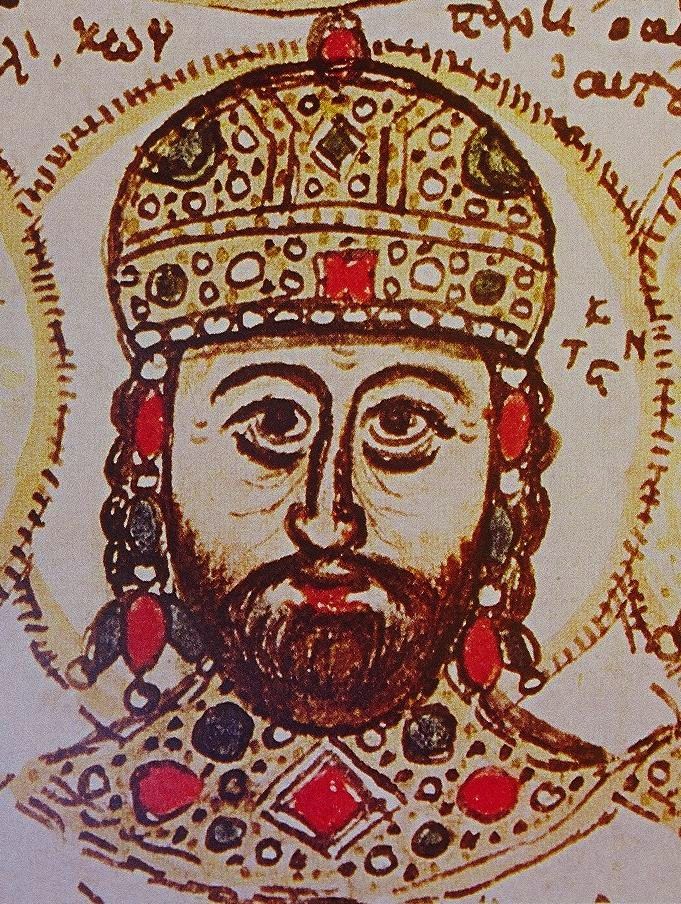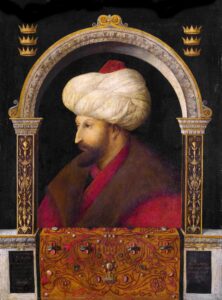The era of World War I transformed global Orthodoxy as we know it and produced the context that we live in today. The Russian Empire fell, and with it the Tsar and the Byzantine double-headed eagle, and the Bolsheviks desecrated Orthodox churches and persecuted the clergy and faithful. So too the Ottoman Empire fell, and with it the last Sultan and Caliph, and secular Turkey converted the Hagia Sophia — the symbol of Ottoman conquest — from a mosque into a museum.
***
According to most Western history books, the Roman Empire ended in AD 476, when the last emperor, Romulus Augustulus, was deposed.
Here is where Orthodox Christians will object — the Roman Empire did not fall in 476; only the weak western half did. In the East, the Empire lasted for almost another thousand years, until the Ottoman Turks captured Constantinople in 1453. Most modern historians call this the “Byzantine Empire,” but that’s a misnomer used to hide the fact that the empire based in Constantinople was, in fact, the Roman Empire.
Some will try to buy a few more years — they’ll point out that the Empire of Trebizond, a spinoff of the Roman Empire, held on for another eight years, until it fell to the Turks in 1461.
“The Third Rome”?
But… what about Russia? While the mythology of Moscow as the “Third Rome” really took off in the 20th century, its origins date back to the 15th. Grand Prince Ivan III of Moscow married Princess Sophia Palaiologina, niece of Emperor Constantine XI Palaiologos, the last “Byzantine” Emperor, who died in the fall of Constantinople. Ivan III was the first ruler of Muscovy (from which Russia later emerged) to style himself as “tsar,” which is directly derived from “caesar” and attests to a Roman imperial self-understanding. Pretty much immediately after 1453, Muscovy adopted the double-headed eagle symbol — the emblem of the “Byzantine” Empire — and it was used by Ivan’s successors until 1917.
The Muscovite Tsars were treated, in the Church, as if they were Roman Emperors. Like their Roman counterparts, they were anointed with Holy Chrism at their coronation. They entered the sanctuary through the Royal Doors and communed at the altar with the clergy. In 1589, when Ecumenical Patriarch Jeremiah issued the charter recognizing the Russian Church as a patriarchate, he declared (some say under pressure),
Because the old Rome has collapsed on account of the heresy of Apollinarius, and because the second Rome, which is Constantinople, is now in possession of the godless Turks, thy great kingdom, O Pious Tsar, is the third Rome. It surpasses in devotion every other, and all Christian kingdoms are now merged in thy realm. Thou art the only Christian sovereign in the world, the master of all faithful Christians.
The Russian Empire that fell in 1917 has at least a defensible claim as being the Roman Empire. No, it was not based in New Rome and was Slavic rather than Greek — but then, New Rome itself was not Old Rome, and the empire based at Constantinople was culturally Greek rather than Latin. (And don’t forget the dark 56 years when the Latins took Constantinople and the Orthodox Emperor had to set up a capital across the Bosphorus at Nicaea.) If we accept that “Byzantium” was in fact the Roman Empire, by extension we must admit that location and culture are not, in and of themselves, essential to the claim of being the Roman Empire. The Russian case ultimately depends on the Tsar taking the Roman Emperor’s place in the Orthodox Church — for better or worse.
“Kayser-i Rum”?
Of course, the Russian claim is far from airtight, and they’re not the only claimant that World War I killed off. In 1453, when the Ottoman sultan Mehmet II conquered Constantinople, he declared himself to be “Kayser-i Rum” — that is, Roman Emperor.
The term Rum (“Roman”) is usually associated with either the ethnic Greeks, or all of the Orthodox, in the Ottoman Empire. But that’s not the only way the term was used. In his fascinating paper “The Ottoman Identity: Turkish, Muslim or Rum?” (Middle Eastern Studies 48:4, July 2012), F. Asli Ergul writes that the Ottoman conquerors of the Roman Empire also applied this term to themselves.
[T]he Ottoman dynasty, by defining itself as Rum, internalized the hegemonic and multi-cultural structure of the Eastern Roman Empire (Byzantine Empire). Obviously it was a declaration of the Ottoman Sultan’s seizure of the heritage of the Eastern Roman Empire. Although this title was not recognized by either the Greeks or the Europeans, the Ottoman dynasty defined itself as the successor to the same territories on which Byzantium had ruled for more than a millennium. A cultural and territorial bond, not an ethnic one, with the Eastern Roman Empire and their direct heirs in the Ottoman Empire, the Orthodox Greeks, was underlined with the Rum identification.
In fact, over the centuries many ethnic Greeks abandoned their Orthodox faith and embraced the Islamic religion of the conqueror, to the point that today, in part because of the intermingling of ethnic Greeks with Turks (i.e., Central Asians) in the Ottoman Empire, genetic studies (such as this one) have found that modern Turks are closer, genetically, to Mediterranean and Middle Eastern people than to Central Asians. Even Mehmet the Conqueror’s own mother was (depending on the source you prefer) Serbian, Italian, or Greek.
Mehmet controlled New Rome itself, and while he could not, as a Muslim, step into the role the Christian Emperor had in the Orthodox Church, he still viewed himself as a key player in Orthodoxy. Runciman writes in The Great Church in Captivity, “He was proud to see himself as the heir of the Caesars and was ready to shoulder the religious responsibilities of his predecessors, so far as his own religion permitted.”
As the centuries went by, the Ottoman Emperors meddled in Orthodox affairs — but then, so had their Byzantine imperial predecessors. The big difference was that the Byzantine Emperors were Orthodox… most of the time. Of course, there were the Arian emperors, and the emperors who sided with other heresies — who can forget the sufferings of St Maximos the Confessor, who had his tongue cut out and his hand cut off at the orders of the Monothelite Roman Emperor? And then the scourge of iconoclasm, when numerous Roman Emperors persecuted the Orthodox faith and desecrated the holy icons. Islam itself is, of course, opposed to the veneration of icons, and St John of Damascus — who had first-hand knowledge of Islam — connected it to Arianism and referred to it as a “heresy” in his book Concerning Heresies. And finally, in the last days of Byzantium, Emperor John VIII Palaiologos betrayed Orthodoxy and embraced a false union with the Roman Catholic Church.
The Ottoman Empire that fell in 1922 has at least a defensible claim as being the Roman Empire. No, it was not Orthodox — but then, the Roman Empire founded by Augustus was pagan until St Constantine, and in the millennium that followed, numerous Roman Emperors were heretics and persecuted the Orthodox Church. Thus if we accept that “Byzantium” was in fact the Roman Empire, by extension we must admit that Orthodoxy is not, in and of itself, essential to the claim of being the Roman Empire. The Ottoman case ultimately depends on the continuity between the “Byzantine” Emperors and Mehmet and his successors — the continuity of title, of territory, and of subjects.
***
The Russians had a Caesar (Tsar) who communed at the altar like a Roman Emperor; they had the double-headed eagle and the self-identification as the new New Rome (ultimately winning the agreement of Ecumenical Patriarch Jeremiah) — and all of it began at basically the moment Constantinople fell.
The Ottomans had a Caesar (Kayser-i Rum) who controlled the capital, territory, and subjects of the Roman Empire, and self-identified as Rum from the standpoint of imperial succession — and all of it began at the precise moment Constantinople fell.
Whether you prefer one claim or the other (or reject them both) it’s rather amazing to observe that both Empires — seemingly conjoined twins — disintegrated at the same historical moment, as a consequence of the same World War, in which the two Empires fought on opposite sides.
And in the shadow of these concurrent imperial falls, we stand at the precipice of an uncertain future: Russian Orthodoxy rose from the ashes of Communism, and the Russian state re-adopted the double-headed eagle; and now, under President Erdogan, we witness secular Turkey signal a shift back toward its Islamic and imperial past.
Which brings us back to our original question:
When did the Roman Empire end — 1917 or 1922?
Yes.



Fascinating analysis. This content is why I keep coming back. May the Lord continue to bless your efforts!
Wasn’t the HRE did the same thing too? I don’t know the detail about them though.
Fascinating article. Well done.
John VIII didn’t betray anything. He was a hero who died fighting for his people. He faced insurmountable odds and kept fighting.
Are you talking about Constantine XI, who died defernding Constantinople in 1453? John VIII was the emperor behind the false union of Ferrara-Florence.
Rome is still there. Many old buildings are still there. The Roman genes as still inside the Italian people. German Romulus descant.
Sure, the city of Rome still exists, but I was referring to the Roman Empire.
“We are a thousand times more byzantine that the French”–Prof. Murat Cizakca
In any case, the Ottomans took almost all Byzantine institutions, such as customs and tax collection. For example, the Roman-Byzantine land system continued in the Ottoman Empire. This means that Roman law continues [in the Turkish Republic]. Similarly, in the [Turkish] Republic, 90 percent of the lands belong to the state….just as I feel proud to be a child of the Ottoman Empire, I also feel proud to be a child of Byzantium”
http://www.radikal.com.tr/turkiye/fransizlardan-bin-kat-bizansliyiz-732901/
A really well written and well rounded article its pretty neat.
Thank you!
If there was a western pause it ended in late 1918 but if going by the Orthodox calender it was in early 1919. However the Prussian Constitution was never abolished by it’s peoples or citizens or done so illegally by spoils of WWII after 1947. There again depending on Orthodox Calendar it was early spring of 1947. But following Prussian history even Catherine the great was of Prussian decent and became leader of Russia. Now when the Tsars were overthrown and the USSR was installed one could say operationally it ended then and there. But the USSR has evaporated now so by Orthodoxy it technically still exist to this day as Russia and it’s leader is the Head of the Russian Orthodox church in Moscow and the functioning government is currently under operational control of Vladimir Putin. The release of the Orthodox church of Ukraine by the head in Moscow was a purging and no longer a direct connection to the Prussian Holy Roman Empire. Russia still hold on too the double headed eagle which was derived from the Prussian Eagle. Much if not all of Ukraine was brought into the age of enlightenment by Catherine.